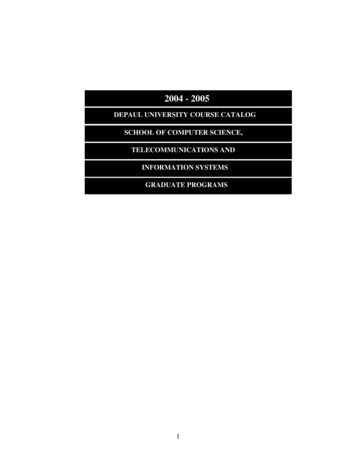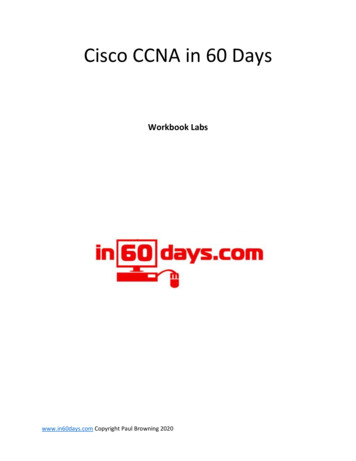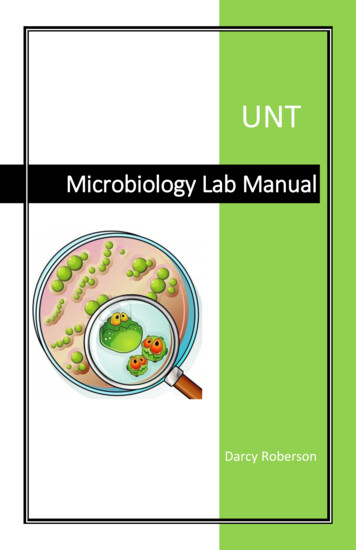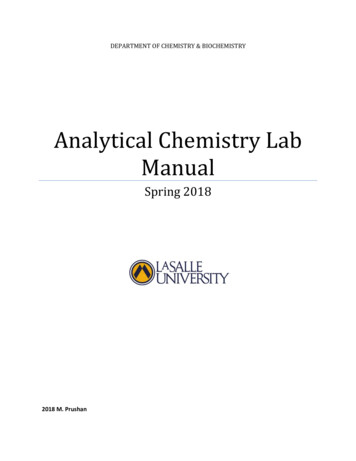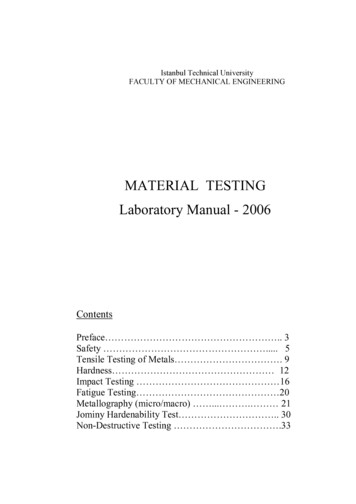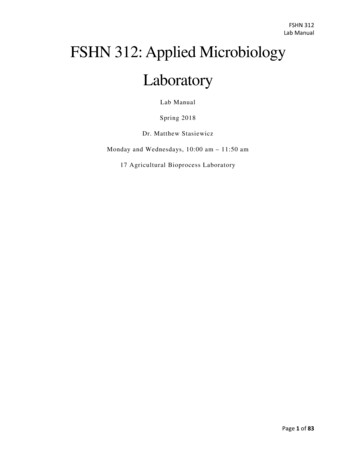
Transcription
FSHN 312Lab ManualFSHN 312: Applied MicrobiologyLaboratoryLab ManualSpring 2018Dr. Matthew StasiewiczMonday and Wednesdays, 10:00 am – 11:50 am17 Agricultural Bioprocess LaboratoryPage 1 of 83
FSHN 312Lab ManualTable of ContentsLab 1 -Basic Microbiology Review. 3Lab 2 -Intrinsic and Extrinsic Properties and their Impact on Microbes . 8Lab 3 -Principles of Quantification and Food Contact Surface Testing . 13Lab 4 -Coliform Follow-Up . 22Lab 5 -D and Z Values . 33Lab 6 -Pathogen Detection in Foods . 37Lab 7 -Outbreak Investigation . 44Lab 8 -QMRA: Quantitative Microbial Risk Assessment . 51Lab 9 -Bacterial Fermentation: Sauerkraut . 55Lab 10 - Bacteriophage . 59Lab 11 - Bacterial Fermentation: Lactic Acid Bacteria and Yoghurt . 63Lab 12 - Spoilage Microbes . 67Lab 13 - Yeast Fermentations: Winemaking . 72Lab 14 - Extra Credit: Fermentation @Home . 82Page 2 of 83
Basic Microbiology ReviewLab 1 -FSHN 312Lab ManualBasic Microbiology ReviewLearning Objectives Demonstrate proper aseptic technique for transfer of cultures to broth and to a platePractice streak plating of a diluted bacterial culturePerform serial dilutions of a bacterial cultureApply these methods to quantify the number of bacteria in a cultureBackgroundAseptic technique is crucial to prevent contamination of samples, to maintain safety of laboratorypersonnel, and to ensure correct results of laboratory analysis. Extreme care should be taken when workingwith microbial cultures, laboratory equipment, and supplies.Microbes can be grown on a solid medium in petri plates for a number of purposes. For food microbiology,we will be growing microbes on plates for one of two purposes: isolation of individual microbes from acomplex sample that may contain different types of microbes, or enumeration of microbes from a sample.Streak plating, or streaking for isolation, is used to isolate single colonies of microbes in a complex sample.Spread plating is used to enable quantification of the number of microbes in sample.Bacteria in many environments are often present in very large numbers. Stationary phase, pure cultures, ofmany laboratory grown bacterial often reach densities greater than 1 billion individual cells per mL or g ofsample. In fact, at these densities, the bacteria are so numerous they will cause a liquid broth to becomecloudy (which microbiologists call turbid).If one wants to determine the numbers of bacteria present in that very dense sample, a standardmicrobiology method to spread the bacteria out on a solid agar surface such that individual bacteria growto form colonies (spread plating). To achieve this, one first needs to dilute the liquid sample such that asmall volume only contains a small number of total bacterial. Often, this is done by a process called serialdilution where a sample in first diluted by a given factor, say 1 to 10. Then, that 1 to 10 dilution is againdilution another factor of 1 to 10. This can repeat as far as necessary.Guidelines for proper aseptic technique1. Sanitize your laboratory bench before and after each use.a. Spray with 70% ethanol and wipe up2. Use only sterile or single-use inoculating needles, loops, or tips.a. Use the Bunsen burners to sterilize toothpicks by flaming (to just before burning).b. Remove items from bulk packaging by only touching one at a time.3. When working with capped bottles or tubes, remove the cap by manipulating between the smallfinger and the palm of your handa. Always hold the cap in your hand, rather than laying it on the bench top, to avoidcontamination.4. When uncapping microcentrifuge tubes, use your thumb to pop open the lid. Take care not totouch the inner lip of the tube.5. When using the pipettor, keep the pipettor upright and change tips when necessary.a. Turning the pipette sideways can cause fluid to enter the pipettor. This will causecontamination of all the samples prepared with that pipettor.Page 3 of 83
Basic Microbiology ReviewFSHN 312Lab Manualb. Get a new, sterile, tip when pipetting a new solution.6. Work under a flame for experiments sensitivity to contamination.a. Upward convection will prevent fungal spores from landing on materials.Guidelines for labeling plates and tubesAll cultures and solutions must be labeled to ensure safety and tracking of experiment. Think two questions:Can an outside be able to identify the organism and/or solution? Can I figure out what this item was for if?To achieve this, specifically:1. All items should be labeled:a. For safety – Organism and media, e.g. E. coli on PCAb. For tracking – Initials or group and date, e.g. g1 1/1/17c. For the experiment – The treatment, e.g. controld. A full label might be: control E. coli on PCA g1 1/1/172. Guidelines for plates and tubesa. Plates – Label the bottom (agar plate) along the rimb. Tubes – Label tape places near the top of the tube3. Sets of plates or tubes should also be labeled with group informationa. Plates – Label the tape securing the stack with safety and tracking information.b. Tubes – Label the rack holding the tubes with safety and tracking information.c. Redundant information can be left off individual labels if the first item is fully labeled.MaterialsSterile, clear microcentrifuge tube (1 per person)Sterile, clear microcentrifuge with 1 mL TSB (1 per person)Escherichia coli on Plate Count Agar (1 plate per group)1mL Tryptic Soy Broth (2 per person)Disposable sterile inoculating loops or long toothpicksPlate Count Agar plates (2 per person)Escherichia coli in 5mL TSB (1 tube per group)Disposable sterile inoculating loops or short toothpicksPlate Count Agar (PCA) plates (4 plates per group)Dilution tubes filled with 900µL of dilution buffer (7 tubes per group)E. coli culture at stationary phase density (1 per group)Sterile spreaders (4 per group)Pipettes, tips.Sharpies, tape, tube racks, votexer, (opt.) plate spinnerProceduresDay 1Aseptic Broth Transfer1. Collect one clear, empty microcentrifuge tube and one 1 mL sterile broth tube from the supplycounterPage 4 of 83
Basic Microbiology ReviewFSHN 312Lab Manual2. Label both tubes with your initials, Group #, and what it’s for (T transfer, S source)e.g. MJS G1 T3. Using aseptic technique, transfer 500µL of sterile broth into the sterile empty tube4. Place both tubes, each with 500µL, in on section of your group’s rack. Label the rack, usingtable, with the group, date, and condition, e.g. TSB g1 1/1/20175. Incubate at Room Temperature (RT) on bench.Aseptic Colony Transfer1. Collect the agar streak plate with bacterial colonies, and two 1.5mL Eppendorf tubes2. Label the broth tubes with your initials and the following conditionsa. ‘ ’ for Inoculatedb. ‘-‘ for Negative control3. Pick a single colony from the plate with an inoculating loop and place it into the tube of sterilebroth labeled ‘inoculated’a. Use a second sterile loop to touch a blank section of agar and place it into the tube ofsterile broth labeled ‘-’4. Incubate at RT on benchStreak Plating for Isolation1. Collect one agar plate, a tube of E. coli culture, and inoculating loops or toothpicks2. Label the bottom of the plate fully e.g. Streak Plate E. coli on PCA MJS 1/1/20173. Using aseptic technique, streak the plate with the culture provideda. Use the method demonstrated by the instructor and below.b. When streaking for isolation on an agar plate, only open the lid as much as necessaryto accomplish the task. Avoid removing the lid completely, because the room is notsterile, and contamination may occur.c. Work under flameStreaking for isolation methodGet a newloop/toothpickGet a newloop/toothpickPage 5 of 83
Basic Microbiology ReviewFSHN 312Lab Manual4. Let the plate dry for 5-10 minutes5. Incubate plates upside down at bench.Serial dilutionsNOTE: change pipettes between transfers.1. Label the bottom of 3 PCA plates with your initials and date, culture and media, and dilution (oneeach of 10-7, 10-6 and 10-5). These are used in ‘spread plating’ section.a. E.g. 10-7 E. coli on PCA MJS 1/1/20172. Transfer 100µL of stock culture to 900µL dilution blank.3. Vortex the tube to ensure homogeneous mixing of culture.4. Repeat 7 times.a. Transfer 100µL of this to a 900µL dilution blank.b. Vortex the tube to ensure homogeneous mixing of culture.Spread plating1. Transfer 100µL of the 10-7 diluted culture to your appropriately labeled plate.2. Spread the sample on the surface of the plate using a sterile spreader.a. Repeat for the 10-6 and 10-5 diluted culture3. Incubate the plates upside down at bench.Day 21. Record results from broth tubes and plates in your lab notebook.2. Count colonies on each of the dilution platesa. Remember that a countable range on standard petri dishes is 25 to 250 colonies (readreview material to know how to interpret counts – you may need to do estimatedcounts).3. Calculate the number of colony forming units of bacteria present in your solution at the timeof platinga. Use the averages (means) of all plates for your lab group for a specific dilution factor.Also make sure that you are multiplying the counts by the correct dilution factor.Counts should be in scientific notation with only 2 significant figures.4. Discard plates and tubes in the biological wastebaskets or appropriate racks.Discussion Questions1. Why do broth culture tubes become turbid after inoculation with a small amount of bacteriaand incubation for a long time?2. Did you observe any growth in either of your “Transfer broth” tubes after incubation (afterperforming the aseptic broth transfer)? What would it mean if microbial growth was presentin the tubes?3. How does streak plating work to generate isolated colonies? If one does not obtain isolatedcolonies, what could one try next time to obtain them?4. Describe the difference between streak plating and spread plating, and provide two exampleswhen a food microbiologist would perform streak plating and two examples when she wouldperform spread plating.Page 6 of 83
Basic Microbiology ReviewFSHN 312Lab Manual5. Describe why serial dilution of a sample is important for reducing media use in a laboratory.For example, what volume of media would be needed to dilute 100µL of a culture to the 10-8dilution used in this lab in a single step.6. What does it mean if some plates have too many colonies on them to count? How would youfix this? What does it mean if a spread plate has none, or too few colonies to count? Howwould you fix this?Page 7 of 83
Intrinsic and Extrinsic Properties and their Impact on MicrobesFSHN 312Lab ManualLab 2 - Intrinsic and Extrinsic Properties and their Impact onMicrobesLearning Objectives Give examples of intrinsic and extrinsic factors in a given foodExplain how tolerance or sensitivity to a given intrinsic or extrinsic factor can impact a microbe’sability to grow on a foodBackgroundIntrinsic factors are properties that are inherent to the food, and play an important role in the ecology offood microbes. These factors include pH, water activity, osmotic pressure, oxidation-reduction potential,nutrient content, antimicrobial constituents, and biological structures.Extrinsic factors are properties that are not part of the food, but properties related to the storage and/orpackaging of the food. Extrinsic factors also play a role in the ecology of food microbes, and includeproperties such as temperature, relative humidity, and atmospheric gasses.The purpose of this lab is to demonstrate how different intrinsic and extrinsic factors impact microbialgrowth. You will examine the effects of pH, osmotic pressure, and temperature on microbial growth, andthe types of microbes that are able to grow under each condition.Osmotic pressure is the force with which a solvent moves from a solution of low solute concentration toa solution of high solute concentration when the solutions are separated by a semipermeable membrane. Inthis case, the semipermeable membrane is the cell membrane. A hypotonic solution is when there is a lowconcentration of solutes outside the cell. Most bacteria can survive this condition, however in veryhypotonic solutions some bacteria will die as the cell begins to uncontrollably swell, leading to osmoticlysis of the cell. A hypertonic solution is when there is a higher concentration of solutes outside the cellthan within. This can lead to loss of water from the cell causing the cell to shrink and collapse. Manymicrobes can be affected in this way.Foods vary by the amount of soluble solutes they contain. Solute used commonly in foods are salts,typically NaCl. Varying concentrations of salt can have dramatic effects on the microbes in a food. Whenhigher concentrations of salt are used in a food, they cause the system to become hypertonic, which canlead to inhibition of growth and decreased survival of many types of microbes. A halophile is a microbethat would survive and grow readily in a hypertonic solution, but would not survive in a hypotonic solution.pH is a measure of the acidity or alkalinity of a solution. Each type of microbe can grow within a specificpH range, which may be broad or limited, with the most rapid growth occurring within a narrow optimumrange. Only a few species of microbes can grow at pH values of less than 2 or greater than 10. Organismsthat live at low pH are called acidophiles, organisms that live at high pH are called alkaliphilic.The pH of foods can vary, and can depend on the type of processing the food undergoes. Foods that arefermented typically have a lower pH than fresh foods. Fruits typically have a lower pH, and the pH of freshmeats is typically around 6. pH also has a dramatic effect on the ability of certain microbes to grow in afood.Page 8 of 83
Intrinsic and Extrinsic Properties and their Impact on MicrobesFSHN 312Lab ManualTemperature also has significant effects on microbial growth. The temperature that foods are stored atcontributes to the ability of microbes to grow on that food. Microbes can grow at various temperatures,and can be classified based on the temperatures at which they can grow. Psychrophiles can grow at lessthan -20 C, with optimum growth rates at -20 to 0 C, and maximum temperature tolerance of 15-20 C.Psychrophiles are not common in foods, they are usually found in specialized environments such as articice. Psychrotrophs can grow at temperatures as low as 4 C, but their optimal growth occurs at 20-30 C.These microbes can grow at refrigeration temperature, but at a slower rate compared to their optimumgrowth temperature. Mesophiles can grow over a range of temperature from 20-45 C, with optimal growthfrom 30 to 40 C. Some mesophiles can survive at low temperature, such as in the refrigerator, but will notreproduce during cold storage. Thermophiles can grow at temperatures over 45 C, with an optimum rangeof 55 to 65 C. Thermophiles are typically only a problem in foods if the foods are held at temperatures justwarm enough for their growth. Thermoduric microbes are a subgroup of mesophilic bacteria whose sporesare able to survive high temperature for certain periods of time. The spores will not germinate untiltemperatures reach the mesophilic growth range, so these microbes are not considered thermophiles. Thevegetative forms of these bacteria are not resistant to heat, only their spores.MaterialsCultures1 per groupAspergillus nigerBacillus stearothermophilusEscherichia coliPseudomonas fluorescensSaccharomyces cerevisiaeListeria innocuaMediaPlate count agar (7 plates per group)Purple broth base with 1% dextrose and Durham tubes (6 tubes per group) *may changePlate count agar with 10% NaCl (1 plate per group)Plate count agar with 15% NaCl (1 plate per group)Plate count agar with 20% NaCl (1 plate per group)Sabouraud dextrose agar 0% NaCl (1 plate per group)Sabouraud dextrose agar 10% NaCl (1 plate per group)Sabouraud dextrose agar 15% NaCl (1 plate per group)Sabouraud dextrose agar 20% NaCl (1 plate per group)5mL Trypic soy broth pH 3.0 (5 tubes per group)5mL Trypic soy broth pH 5.0 (5 tubes per group)5mL Trypic soy broth pH 6.0 (5 tubes per group)5mL Trypic soy broth pH 7.0 (5 tubes per group)5mL Trypic soy broth pH 10.0 (5 tubes per group)Page 9 of 83
Intrinsic and Extrinsic Properties and their Impact on MicrobesFSHN 312Lab ManualFoodsBrown sugar (5g per group)Ocean fish with skin (11g per group)Plain yogurt (11g per group)Miscellaneous99 mL dilution blanks (1 bottle/group)Stomacher bag for fish (1 bag/group)Beaker for putting stomacher bag in after mixing (1 /group)Pipettes and tips50 mL graduate cylinders (1/group)BalancesWater bath at 90oC4oC incubator space for one basket and one rack55oC Incubator space for 1 rackRack, labeled “55oC”Basket, labeled “Refrigerated”Cutting board/sharp knifeProceduresResistance to osmotic pressuresFirst day of lab:1. Each group, pick up one plate of plate count agar with 0, 10%, 15%, and 20% NaCl.2. Draw a dividing line on the bottom of each plate, to divide the plate in half.3. Inoculate a single line of E. coli to one-half of each plate and a single of line of L. innocua to theother half of each plate.4. Each group, pick up one plate of Sabouraud dextrose agar containing 0, 10%, 15%, and 20% NaCl.5. Draw a dividing line on the bottom of each plate and inoculate as previously, only this time use S.cerevisiae (a yeast) and A. niger (a mold) as inoculum. Be careful with the A. niger. Avoidcontaminating your plate with loose spores; knock them loose from the inoculating loop on theinterior of the tube prior to transfer.6. Incubate all of the plates, inverted, at RT.Second day of lab:1. Compare and record growth of each organism on the different plates.Impact of pH on growthFirst day of lab:1. Each group, pick up 5 tubes of TSB at each pH (3, 5, 6, 7, and 10; total 25 tubes per group).2. Each group will need 11g of yogurt.3. Add to 99 mL of the dilution water, shake for 30 s.4. Pipet 0.1 mL of the diluted yogurt mixture into one TSB tube at each pH.a. Inoculate E. coli into one TSB tube at each pH.b. Inoculate B. stearothermophilus into one TSB tube at each pH.c. Inoculate L. innocua into one TSB tube at each pH.d. Inoculate S. cerevisiae into one TSB tube at each pH.5. Incubate all tubes at room temperature in your locker.Page 10 of 83
Intrinsic and Extrinsic Properties and their Impact on MicrobesFSHN 312Lab Manual6. Discard dilution bottle in baskets indicated.Second day of lab:1. Observe and record the pHs at which each organism grew.2. The tubes may be discarded in the basket indicated.Psychrotrophs and MesophilesFirst day of lab:1.2.3.4.5.6.7.8.9.Each team will need 11 g of the fish sample.Add the fish sample and 99 mL of dilution water to a stomacher bag. Manually mix for 2 min.Each group will need 6 plates of plate count agar for this experiment.Using your inoculating loop, streak the homogenate of fish on two of the plates. Be sure to haveyour inoculating loop pass through the foam and into the water phase of the fish sample.Mark the plates for identification with one labeled RT for room temperature, and the other 4oC.On two more plates streak from the E. coli culture – incubate one at RT and one at 4oC.On the final two plates streak from the Pseudomonas fluorescens culture – incubate one at RT andone at 4oC.Incubate the RT plates in your locker. Place the 4oC plates in a labeled basket for incubation.Discard dilution bottles and stomacher bags in baskets indicated.Second day of lab:1. Compare growth on the plates for amount, appearance and general growth rate (slow vs. fast). Makea note of any differences, such as colony size, texture, color, or obvious odor (do not directly sniffthe plates) between treatments.Thermophiles and Thermoduric MesophilesFirst day of lab:1.2.3.4.5.6.7.8.9.Each group weigh out a 5 g sample of brown sugar.Dissolve the brown sugar in 20 mL of tap water in a 50 mL falcon tube.Heat in a 90C water batch for 2 min. Allow solution to cool before pipetting.Obtain 6 tubes of purple broth base with 1% dextrose.Pipette 1 mL of the sugar sample into 2 tubes of purple broth base with 1% dextrose (1ml/tube).Pipettes should be discarded in the waste bag in the bucket on the bench.Incubate 1 tube at 55oC (place in labeled rack), incubate the other in your locker (RT).Inoculate 2 of the other tubes with the E. coli culture – incubate 1 tube at RT and the other at 55oC.Inoculate the last 2 tubes with the Bacillus stearothermophilus culture – incubate 1 tube at RT andthe other at 55oC.The instructor will move the tubes from the 55oC incubator to the cold room on Thursday to preventcolor changes due to prolonged heating.Page 11 of 83
Intrinsic and Extrinsic Properties and their Impact on MicrobesFSHN 312Lab ManualSecond day of lab:1. Look for production of acid (yellow) and/or gas in the Durham tube as an indication of growth.Compare growth (turbidity) in the tubes.2. The tubes may be discarded in the basket indicated.Discussion Questions1. Which microbes are more tolerant to the high salt conditions? What are the implications of themicrobe’s salt tolerance to its ability to survive on foods?2. What differences did you note between treatments for thermophiles and thermoduric mesophiles?Which, if any, tubes indicate the growth of thermophiles and which indicate growth of thermoduricmesophiles? What implications does this have for heat processed foods?3. What intrinsic and/or extrinsic factors are the microbes from the food samples able to grow on?How does this relate to the properties of each food?Page 12 of 83
Principles of Quantification and Food Contact Surface TestingFSHN 312Lab ManualLab 3 - Principles of Quantification and Food Contact SurfaceTestingLearning Objectives Describe appropriate procedures for collecting food samples for microbiological testingDescribe the purpose of the aerobic plate count and two ways to conduct this testCalculate the microbial load of a food sampleExplain why food contact surfaces should be tested for the presence of microbesBackgroundGeneralYou will also need to read chapter 3 (Standard Plate Count) and appendix 2 (MPN) from the Food and DrugAdministration Bacteriological Analytical Manual (often referred to as the BAM). I recommend readingthem online or printing multiple pages per sheet to save on printing. Anyone doing food microbiology intheir careers would need these resources. We will use these methods throughout the rest of this semester.For a thorough background and description of quantitative methods in Food Microbiology, you could alsoread chapters 3, 6, and 7 from the “Compendium of Methods for the Microbiological Examination of Foods"(non-circulating at ACES library).You will also need to download the 3M reminders for use and interpretation guide for the Petrifilm AerobicPlate Count films. These can be found on the Compass site (1 document).The three classical methods available for estimating microbial numbers in foods are:1. The aerobic plate count (APC), which is sometimes also referred to as the total plate count (TPC),the standard plate count (SPC), the total viable count, the average plate count, or the aerobicmesophilic count. In this class we will call it APC.2. The most probable number (MPN) technique.3. The direct microscopic count (DMC).Keep in mind that there are other methods that can be used in the quantification of microorganisms in foods.For this laboratory exercise we will quantify microorganisms in various food samples and surfaces usingvariations of APCs and the MPN method.Aerobic Plate CountThe Aerobic Plate Count (APC) is used as an indicator of the bacterial numbers in a food sample. It mayalso be called the total plate count, standard plate count (usually for dairy products), or mesophilic count.Since not all microorganisms can grow in a single agar medium using a single set of incubation conditions,this method is considered, at best, an estimation of the microbial load of a food. Despite the drawbacks ofthe method, the plate count remains the standard to which all alternative methods are compared. It is anespecially useful method to detect low numbers of microorganisms. Different foods can contain a widerange of concentration of bacteria such that dilutions are made of the food in liquid medium and aliquotsare plated onto a solid medium. Each bacterium will multiply to form a visible colony. These numbers arecounted and multiplied by the dilution factor to give colony forming units (CFU) per gram or milliliter.Since microorganisms can grow as single cells or as chains, clusters or filaments, the total count should bereported as colony forming units (CFU) per mL or g instead of cells or bacteria per mL or g.Page 13 of 83
Principles of Quantification and Food Contact Surface TestingFSHN 312Lab ManualTotal microbial numbers in a food sample can also be estimated by the pour or spread plate methods, spiralplating, or pectin gel plate counts (Petrifilm or Redigel ). In today’s lab, we will enumeratemicroorganisms from foods, by using pour plates, spread plates, and Petrifilm.In the pour plate method, 1.0 or 0.1 mL of the sample is pipetted into a sterile Petri dish to which temperedagar (45 C) is added. The spread plate method is similar to pour plate method, except that Petri dishes arerepoured with agar which is allowed to solidify prior to plating samples. Usually, a 0.1-mL sample isdeposited onto the surface of the agar and spread with a sterile disposable plastic spreader. Incubation isperformed under the same conditions as for the pour plate method.In the pectin gel methods (ex: Petrifilm), two plastic films are attached together on one side and coatedwith culture medium ingredients and a cold-water-soluble jelling agent. To use, 1 mL of diluents is placedbetween the two films and spread over the nutrient area by pressing with a special spreader.Following incubation, microcolonies appear red on the film because of the presence of a tetrazolium dye inthe nutrient phase. Like the spread plate method, pectin gel methods are particularly useful to estimate thenumber of bacteria that might be sensitive to the temperatures of molten agar. Since no media preparationis required, pectin gels are easy to use and offer consistent results. However, they are more expensive thantraditional methods such as pour plates or spread plates. Several types of pectin gels exist and are used inthe food industry, but the most popular are the Petrifilm gels, produced by the 3M Company.Once a total microbial count has been obtained, it provides an estimate of the viable microorganisms thatcan grow under the conditions provided (medium, temperature, oxygen concentration, time of (incubation).Colony counts may be affected by numerous factors, including nutrients available in the medium,incubation temperature and time, oxidation-reduction potential, cell injury, and presence of inhibitorysubstances in the food or medium. The accuracy of the count can be hindered by contamination (often frompoor aseptic technique), improper food sampling and dilution preparation, etc. Therefore, it is essential topractice good microbiological techniques to minimize error.The Most Probable Number (MPN) technique is a serial dilution test used by microbiologists to estimateconcentrations of viable microbes when plate-counting methods are not feasible, or when an approximationof total microbes, rather than a total plate count, is sufficient. The MPN method is also useful in caseswhere microorganisms are present in very low numbers within a food product (less than 250microorganisms per gram or milliliter of sample), or when food particulate matter may obscure colonycounts on agar.Most Probable NumberThe MPN technique is commonly used to estimate coliforms in a food product, but is also useful forestimating a general aerobic microbial count. In the MPN method, a food homogenate is decimally dilutedto extinction, which means that it is diluted until no microbial growth is evident.Generally, samples are diluted to 10-4 or 10-5 in a common diluent, unless the food is expected to contain ahigher number of microorganisms. Dilutions are used to inoculate MPN tubes containing an appropriatebroth medium, and tubes are then incubated at an appropriate temperature and time. After incubation, MPNtubes are examined for signs of microbial growth, and presence or absence of growth is recorded for eachtube. Depending on the type of broth medium used and microorganisms present, tubes with positivemicrobial growth can be identified based on turbidity of the broth, color change if a color indicator wasadded to the medium, production of gas, production of metabolites or reduction of chemicals.Page 14 of 83
Principles of Quantification and Food Contact Surface TestingFSHN 312Lab Manual
Basic Microbiology Review FSHN 312 Lab Manual . Page 7 of 83. 5. Describe why serial dilution of a sample is important for reducing media use in a laboratory. For example, what volume of media wo




